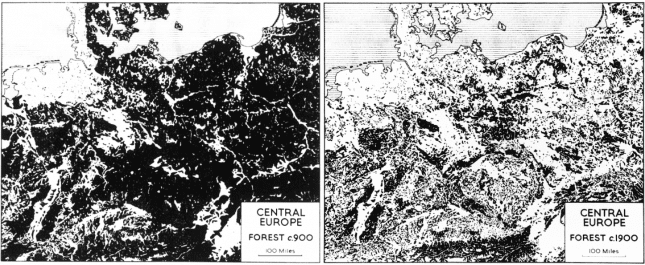
Massive reforestation can’t save us from runaway global warming, despite what intuition might tell us. According to a recent study which simulated CO2 removal from a biosphere point of view, biomass plantations would be inadequate in steering us away from a potentially disastrous 2 degrees Celsius global warming scenario. Instead, we have to cut off fossil fuels immediately and plant biomass at the same time if we’re to have a winning shot at this.
Trees — don’t overestimate them
We all know deforestation is running rampant all over the world. According to the World Resources Institute, more than 80 percent of the Earth’s natural forests already have been destroyed. Up to 90 percent of West Africa’s coastal rain forests have disappeared since 1900. This destruction is continuing on a daily basis. The U.S. State Department estimates that forests four times the size of Switzerland are lost each year because of clearing and degradation. That’s because every year our cities grow bigger, and so do our crop fields and industrial centers to support an ever growing and affluent population.
Here’s what the forest cover in Central Europe used to look like some 1,100 years ago.

Trees are incredibly useful. They provide shelter and food for millions of species, enrich the soil, and — perhaps most importantly — suck out CO2 and expel O2. That’s literally the reverse of human respiration and for millions of years, this delicate interplay has worked out just fine for everyone. But then humans started digging and burning billions of tonnes of carbon that was stored in the crust for ages. Coupled with massive deforestation, human activity has released so many greenhouse gases into the atmosphere that the world is now nearly 1 degree Celsius warmer than at the start of the Industrial Revolution.
Though alarmed, some people might feel comfortable knowing that we can always replant our forests to offset all the damage we’ve caused in the last 150 years. But that’s just wishful thinking, according to an international team of researchers who simulated what would happen if we grew biomass under three scenarios: business as usual (unabated burning of fossil fuel resources), Paris Agreement (190+ countries pledged to reduce or cap emissions on a case by case basis. For instance, the U.S. pledged to lower emissions by at least 26 percent below 2005 levels by 2025), and very ambitious CO2 reductions.
The team found that if we continue to burn fossil fuels at this current rate, the number of trees we’d need to plant would be simply staggering and impractical. Even if we’d plant nothing but poplar trees or switchgrass, which have some of the highest density of stored biomass (50% carbon), under this scenario the size of the plantation would replace natural ecosystems around the world almost completely.
“If we continue burning coal and oil the way we do today and regret our inaction later, the amounts of greenhouse gas we would need to take out of the atmosphere in order to stabilize the climate would be too huge to manage,” says Lena Boysen from the Potsdam Institute for Climate Impact Research (PIK), Germany, lead-author of the study published in a journal of the American Geophysical Union, Earth’s Future.
In the case of scenario #2, even if all the Paris pledgers put their money where their mouth is, we’d still be in trouble. The biomass plantations required by mid-century to extract all that remaining excess CO2 from the atmosphere would be enormous. We’d have to replace natural ecosystems on fertile land the size of more than one-third of all forests we have today on our planet. If that’s not an option, we can always convert a quarter of the land used for agriculture into biomass plantations. But in doing so, we’d seriously jeopardize global food security.
Lastly, if the world was very serious about climate change and ambitiously decided to reduce carbon emissions, then fierce competition for land and food could be less pronounced than in the other two scenarios. However, even in this scenario, we’d have to use high-tech carbon-storage-machinery that captures more than 75 percent of extracted CO2 to limit warming to around 2°C by 2100.
“As scientists we are looking at all possible futures, not just the positive ones,” says co-author Wolfgang Lucht from PIK. “What happens in the worst case, a widespread disruption and failure of mitigation policies? Would plants allow us to still stabilize climate in emergency mode?”
“The answer is: no. There is no alternative for successful mitigation. In that scenario plants can potentially play a limited, but important role, if managed well.”
The fact is, there is no simple solution such as ‘planting more trees’ to such a complex problem like global warming. Consider the following:
Typically, a tree absorbs as much as 48 pounds (21 kg) of carbon dioxide per year and can sequester 1 ton of carbon dioxide by the time it reaches 40 years old. The average North American generates about 20 tons of CO2-eq each year, which means every year you’d need to plant about 500 trees to offset your own carbon footprint, that’s not taking into account the time it takes for a tree to mature and reach the optimal carbon-sinking age. If you’re a New Yorker and need to fly to Berlin, your seat is responsible for generating 10,285 pounds (4,675 kg) of CO2. Your 8.5-hour-long flight just offset roughly 223 trees!
“Our work shows that carbon removal via the biosphere cannot be used as a late-regret option to tackle climate change. Instead we have to act now using all possible measures instead of waiting for first-best solutions,” says co-author Tim Lenton of the University of Exeter, UK.
“Reducing fossil fuel use is a precondition for stabilizing the climate, but we also need to make use of a range of options from reforestation on degraded land to low-till agriculture and from efficient irrigation systems to limiting food waste.”
The big takeaway here is that mitigating climate change involves all state actors working in coordination and a number of tools. Planting biomass is definitely in our toolset but can’t work alone by itself. We also need renewable energy, an immediate shutdown of fossil fuel activity, as well as high-tech carbon storage and capture.
“In the climate drama currently unfolding on that big stage we call Earth, CO2 removal is not the hero who finally saves the day after everything else has failed. It is rather a supporting actor that has to come into play right from the beginning, while the major part is up to the mitigation protagonist,” says co-author Hans Joachim Schellnhuber, Director of PIK. “So this is a positive message: We know what to do — rapidly ending fossil fuel use complemented by a great variety of CO2 removal techniques. We know when to do it — now. And if we do it, we find it is still possible to avoid the bulk of climate risks by limiting temperature rise to below 2 degrees Celsius.”



